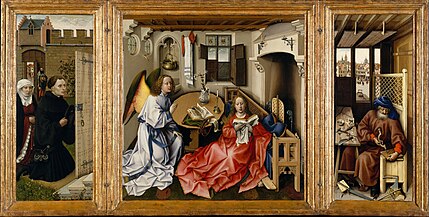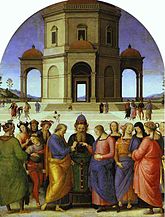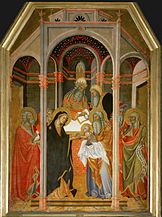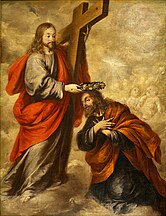Saint Joseph
venerate saints | |
|---|---|
| Feast |
|
| Attributes | Carpenter's square or tools, holding the infant Jesus Christ, staff with lily blossoms, two turtle doves, and a rod of spikenard. |
| Patronage | Catholic Church, among others fathers, workers, married people, persons living in exile, the sick and dying, for a holy death |
| Part of a series on |
| Josephology of the Catholic Church |
|---|
 |
| General articles |
| Prayers and devotions |
| Organisations |
| Papal documents |
|
Catholicism portal |
Joseph (Hebrew: יוסף, romanized: Yosef; Greek: Ἰωσήφ, romanized: Ioséph) was a 1st-century Jewish man of Nazareth who, according to the canonical Gospels, was married to Mary, the mother of Jesus, and was the legal father of Jesus.[2]
Joseph is venerated as Saint Joseph in the
Several venerated images of Saint Joseph have been granted a decree of canonical coronation by a pontiff. Religious iconography often depicts him with lilies or spikenard. With the present-day growth of Mariology, the theological field of Josephology has also grown and since the 1950s centers for studying it have been formed.[8][9]
In the New Testament

The Pauline epistles are the oldest extant Christian writings.[10] These mention Jesus' mother (without naming her), but do not refer to his father. The Gospel of Mark, believed to be the first gospel to be written and with a date about two decades after Paul, also does not mention Jesus' father.[11]
The first appearance of Joseph is in the gospels of Matthew and Luke, often dated from around 80–90 AD. Each contains a genealogy of Jesus showing ancestry from King David, but through different sons; Matthew follows the major royal line from Solomon, while Luke traces another line back to Nathan, another son of David and Bathsheba. Consequently, all the names between David and Joseph are different.
Like the two differing genealogies, the infancy narratives appear only in Matthew and Luke and take different approaches to reconciling the requirement that the Messiah be born in Bethlehem with the tradition that Jesus in fact came from Nazareth. In Matthew, Joseph obeys the direction of an angel to marry Mary. Following the birth of Jesus in Bethlehem, Joseph is told by an angel in a dream to take the family to Egypt to escape the massacre of the children of Bethlehem planned by Herod, the ruler of the Roman province of Judea. Once Herod has died, an angel tells Joseph to return but to avoid Herod's son, and he takes his wife and the child to Nazareth in Galilee and settles there. Thus in Matthew, the infant Jesus, like Moses, is in peril from a cruel king, like Moses he has a (fore)father named Joseph who goes down to Egypt, like the Old Testament Joseph this Joseph has a father named Jacob, and both Josephs receive important dreams foretelling their future.[12]
In the Gospel of Luke, Joseph already lives in Nazareth, and Jesus is born in Bethlehem because Joseph and Mary have to travel there to be counted in a census. Subsequently, Jesus was born there. Luke's account makes no mention of him being visited by angels (Mary and various others instead receive similar visitations), the Massacre of the Innocents, or of the flight into Egypt.
The last time Joseph appears in person in any of the canonical Gospels is in the narrative of the Passover visit to the Temple in Jerusalem when Jesus is 12 years old, which is found only in Luke. No mention is made of him thereafter.[13] The story emphasizes Jesus' awareness of his coming mission: here Jesus speaks to both Mary and Joseph of "my father," meaning God, but they fail to understand.[14]
Christian tradition represents Mary as a widow during the adult ministry of her son. Joseph is not mentioned as being present at the Wedding at Cana at the beginning of Jesus' mission, nor at the Passion at the end. If he had been present at the Crucifixion, he would under Jewish custom have been expected to take charge of Jesus' body, but this role is instead performed by Joseph of Arimathea. Nor would Jesus have entrusted his mother to the care of John the Apostle if her husband had been alive.[15]
While none of the Gospels mentions Joseph as present at any event during Jesus' adult ministry, the synoptic Gospels share a scene in which the people of Nazareth, Jesus' hometown, doubt Jesus' status as a prophet because they know his family. In Mark 6:3, they call Jesus "Mary's son" instead of naming his father. In Matthew, the townspeople call Jesus "the carpenter's son," again without naming his father.[16] In Luke 3:23 NIV: "Now Jesus himself was about thirty years old when he began his ministry. He was the son, so it was thought, of Joseph, the son of Heli,"[17]; or alternatively punctuated: "(ὡς ἐνομ. τοῦ Ἰωσὴφ) τοῦ Ἡλί, ‘the son (as supposed of Joseph, but in reality) of Heli'".[18] In Luke the tone of the contemporary people is positive, whereas in Mark and Matthew it is disparaging.[19] This incident does not appear in John, but in a parallel story, the disbelieving neighbors refer to "Jesus the son of Joseph, whose father and mother we know".[20]
Mentions in the Gospels
| No. | Event | Matthew | Mark | Luke | John |
|---|---|---|---|---|---|
| 1 | Joseph lived in Nazareth | [21] | |||
| 2 | Genealogy of Jesus | [22] Solomon to Jacob | [23] Nathan to Heli | ||
| 3 | Joseph betrothed to Mary | [24] | [25] | ||
| 4 | Angel visits Joseph (1st dream) |
[26] | |||
| 5 | Joseph and Mary travel to Bethlehem | [27] | |||
| 6 | Birth of Jesus | [28] | [29] | ||
| 7 | Temple presentation
|
[30] | |||
| 8 | Angel tells Joseph to flee (2nd dream) |
[31] | |||
| 9 | Flight into Egypt | [32] | |||
| 10 | Angel tells Joseph to return to Nazareth (3rd dream) |
[33] | |||
| 11 | Joseph and family settle in Nazareth |
[34] | [35] | ||
| 12 | Finding Jesus in the Temple
|
[36] | |||
| 13 | Holy Family | [37] | |||
Lineage
Joseph appears in Luke as the father of Jesus and in a "variant reading in Matthew".
The variances between the genealogies given in Matthew and Luke are explained in a number of ways. One possibility is that Matthew's genealogy traces Jesus' legal descent, according to Jewish law, through Joseph; while Luke's genealogy traces his actual physical descent through Mary.[41][42] Another possibility proposed by Julius Africanus is that both Joseph and his father were the sons of Levirate marriages.[43][44] A third explanation proposed by Augustine of Hippo is that Joseph was adopted, and his two genealogies trace Joseph's lineage through his biological and adopted families.[45]
Professional life
In the Gospels, Joseph's occupation is mentioned only once. The Gospel of Matthew asks about Jesus:
Is not this the carpenter's son (ho tou tektōnos huios)?[46]
Joseph's description as a "
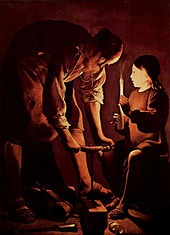
Other scholars have argued that tekton could equally mean a highly skilled craftsman in wood or the more prestigious metal, perhaps running a workshop with several employees, and noted sources recording the shortage of skilled artisans at the time.[51] Géza Vermes has stated that the terms 'carpenter' and 'son of a carpenter' are used in the Jewish Talmud to signify a very learned man, and he suggests that a description of Joseph as 'naggar' (a carpenter) could indicate that he was considered wise and highly literate in the Torah.[52] At the time of Joseph, Nazareth was an obscure village in Galilee, about 130 kilometres (81 mi) from the Holy City of Jerusalem, and is barely mentioned in surviving non-Christian texts and documents.[53][54][55][56] Archaeology over most of the site is made impossible by subsequent building, but from what has been excavated and tombs in the area around the village, it is estimated that the population was at most about 400.[57] It was, however, only about 6 kilometers from the city of Sepphoris, which was destroyed and depopulated by the Romans in 4 BC, and thereafter was expensively rebuilt. Analysis of the landscape and other evidence suggest that in Joseph's lifetime Nazareth was "oriented toward" the nearby city,[58] which had an overwhelmingly Jewish population although with many signs of Hellenization,[59] and historians have speculated that Joseph and later Jesus too might have traveled daily to work on the rebuilding. Specifically the large theatre in the city has been suggested, although this has aroused much controversy over dating and other issues.[60] Other scholars see Joseph and Jesus as the general village craftsmen, working in wood, stone, and metal on a wide variety of jobs.[61]
Modern appraisal
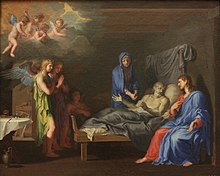
The name "Joseph" is found almost exclusively in the genealogies and the infancy narratives.[62][63]
The canonical gospels created a problem: they stated clearly that Mary conceives Jesus virginally and Joseph is not his father; however, Jesus was described unambiguously by John and Matthew as "Joseph's son" and "the carpenter's son", and Joseph's paternity was essential to establish Jesus'
Modern positions on the question of the relationship between Joseph and the Virgin Mary vary. The Eastern Orthodox Church, which names Joseph's first wife as Salome, holds that Joseph was a widower and betrothed to Mary,[66] and that references to Jesus' "brothers" were children of Joseph from a previous marriage. The position of the Catholic Church, derived from the writings of Jerome, is that Joseph was the husband of Mary, but that references to Jesus' "brothers" should be understood to mean cousins. Such usage is prevalent throughout history, and occurs elsewhere in the Bible. Abraham's nephew Lot (Genesis 11:26-28) was referred to as his brother (Genesis 14:14), as was Jacob's uncle Laban (Genesis 29:15). Jesus himself frequently used the word "brother" as a generic term for one's fellow man. This custom has continued into modern times, with close friends, colleagues, and fellow churchgoers often called "brothers and sisters." Generally, most Protestants read "brothers and sisters" of Jesus as referring specifically to children born of Mary. The doctrine of the perpetual virginity of Mary means among other things that Joseph and Mary never had sexual relations.
The term kiddushin, which refers to the first part of a two-part marriage, is frequently translated as "betrothal". Couples who fulfill the requirements of the kiddushin are married, until death or divorce.[67][68]
Death
The New Testament has no mention of Joseph's death, but he is never mentioned after the story of finding Jesus in the temple when Jesus was 12.[citation needed]
This is in contrast with some eastern traditions that made Joseph out to be 90 years old, a tradition intended to protect Mary's perpetual virginity. In the original Greek the words used to describe Joseph describe him as middle-aged. This fits with Joseph's duties and aligns with the saints who said he was 33 when he married Mary.
Later apocryphal writings

The Gospel of James (also known as the Protoevangelium of James), written about 150 AD, presents Joseph as an old man chosen by God to watch over the Virgin. Jesus' brothers are presented as Joseph's children by an earlier marriage.[69]
The History of Joseph the Carpenter, written in the 5th century and framed as a biography of Joseph dictated by Jesus, describes how Joseph, aged 90, a widower with four sons and two daughters, is given charge of the twelve-year-old Mary, who then lives in his household raising his youngest son James the Less (the supposed author of the Protoevangelium) until she is ready to be married at age 14½. Joseph's death aged 111, attended by angels and asserting the perpetual virginity of Mary, takes up approximately half the story.[70]
Church Fathers
According to the bishop of Salamis,
Origen quotes the Greek philosopher and opponent of early Christianity Celsus (from his work On the True Doctrine, c. 178 AD) as controversially asserting that Joseph left Mary upon learning of her pregnancy: "...when she was pregnant she was turned out of doors by the carpenter to whom she had been betrothed, as having been guilty of adultery, and that she bore a child to a certain soldier named Pantera."[77] Origen, however, argues that Celsus's claim was a fabricated story.[78]
Veneration
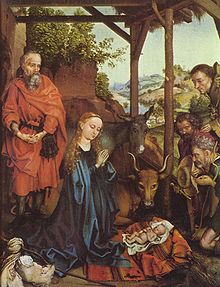
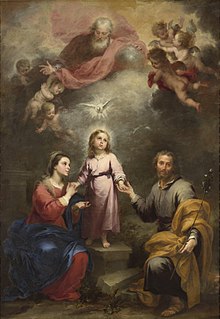
The earliest records of a formal devotional following for Saint Joseph date to the year 800 and references to him as Nutritor Domini (educator/guardian of the Lord) began to appear in the 9th century, and continued growing to the 14th century.[79][80][81] Thomas Aquinas discussed the necessity of the presence of Saint Joseph in the plan of the Incarnation for if Mary had not been married, the Jews would have stoned her and that in his youth Jesus needed the care and protection of a human father.[82][83]
In the 15th century, major steps were taken by
Together with the
In 1962,
Feast days
| Feast of Saint Joseph | |
|---|---|
19 March |
Saint Joseph's Day
19 March, Saint Joseph's Day, has been the principal
Joseph is
Popular customs among Christians of various liturgical traditions observing Saint Joseph's Day are attending
In
Upon a typical Saint Joseph's Day altar, people place flowers, limes, candles, wine, fava beans, specially prepared cakes, breads, cookies, other meatless dishes, and
Saint Joseph the Worker
In 1870,
Espousals of the Blessed Virgin Mary
The
Patris corde and Year of Saint Joseph
Pope Francis on 8 December 2020, released the apostolic letter Patris corde on the occasion of the 150th anniversary of the declaration by Pius IX, on 8 December 1870, of Saint Joseph as patron of the Universal Church; for the same reason he declared a Year of Saint Joseph, from 8 December 2020, to 8 December 2021.[107][108]
Patronage
Pope Pius IX proclaimed Saint Joseph the patron of the Universal Church in 1870. Having died in the "arms of Jesus and Mary" according to Catholic tradition, he is considered the model of the pious believer who receives grace at the moment of death, in other words, the patron of a happy death.[109]
Saint Joseph is well known as the patron saint of fathers, both families and virgins, workers, especially carpenters, expecting mothers and unborn children. Among many others, he is the patron saint of attorneys and barristers, emigrants, travelers and house hunters. He is invoked against hesitation and for the grace of a holy death.[110]
Places, churches, and institutions

Many cities, towns, and locations are named after Saint Joseph. According to the
Many churches, monasteries and other institutions are dedicated to Saint Joseph.
The
Prayers and devotions

In the Eastern Orthodox Church, during the
Verily, Joseph the betrothed, saw clearly in his old age that the foresayings of the Prophets had
been fulfilled openly; for he was given an odd earnest,
receiving inspiration from the angels,
who cried, Glory to God; for he hath bestowed peace on earth.
In the Catholic tradition, just as there are prayers for the
Multiple venerated Catholics have described their devotion to Saint Joseph and his intercession.
Glorious St. Joseph, pattern of all who are devoted to toil,
obtain for me the grace to toil, in the spirit of penance,
in order to thereby atone for my many sins …
There is a Catholic tradition that burying a statuette of Saint Joseph on the grounds of a home will help to sell or buy[120] a house.;[121] this tradition became so popular through the World Wide Web that some American realtors bought them by the gross.[122]
St. Joseph's role in the Catholic church is summarized by the German theologian Friedrich Justus Knecht:
St. Joseph’s high place in the kingdom of God comes from this, that God chose him to be the guardian and protector of His Son, entrusting him with what was greatest and dearest to Himself, singling him out and especially blessing him for this office. The Church celebrates a Feast in honour of St. Joseph on 19 March, and desires that all the faithful should honour him, ask for his intercession, and imitate his virtues. St. Joseph is the especial patron of the Church. Even as he was the protector of the Child Jesus on earth, so, we believe, is he now the protector of the mystical Body of Jesus, His holy Church. We also especially seek his intercession for a good death, because, having died so blessedly, in the presence and with the assistance of Jesus and Mary, he should be supplicated to obtain for us from Jesus the grace of a happy death.[123]
In art

In mosaics in the basilica of Santa Maria Maggiore (432-40) Joseph is portrayed young, bearded and dressed as a Roman of status.[124] Joseph is shown mostly with a beard, not only in keeping with Jewish custom, but also because – although the Gospel accounts do not give his age – later legends tend to present him as an old man at the time of his wedding to Mary. Earlier writers thought the traditional imagery necessary to support belief in Mary's perpetual virginity.[125] Jean Gerson nonetheless favoured showing him as a younger man.[126]

In recent centuries – in step with a growing interest in Joseph's role in Gospel exegesis – he himself has become a focal figure in representations of the Holy Family. He is now often portrayed as a younger or even youthful man (perhaps especially in
However Carolyn Wilson challenges the long-held view that pre-Tridentine images were often intended to demean him.[129] According to Charlene Villaseñor Black, "Seventeenth-century Spanish and Mexican artists reconceptualized Joseph as an important figure, ... representing him as the youthful, physically robust, diligent head of the Holy Family."[130] In Bartolomé Esteban Murillo's The Two Trinities, Saint Joseph is given the same prominence as the Virgin.[citation needed]
Full cycles of his life are rare in the Middle Ages, although the scenes from the Life of the Virgin or Life of Christ where he is present are far more often seen. The Mérode Altarpiece of about 1425, where he has a panel to himself, working as a carpenter, is an early example of what remained relatively rare depictions of him pursuing his métier.[citation needed]
Some statues of Joseph depict his staff as topped with flowers, recalling the non-canonical Gospel of James's account of how Mary's spouse was chosen by collecting the walking sticks of widowers in Palestine, and Joseph's alone bursting into flower, thus identifying him as divinely chosen.[
Chronology of Saint Joseph's life in art
-
Joseph andDürer, 1504
-
At work in the Mérode Altarpiece, 1420s, attributed to Robert Campin and his workshop
-
Joseph's Dream, Rembrandt, c. 1645
-
Marriage to the Virgin, Perugino, c. 1448
-
Marten de Vos1577
-
The Adoration of the Magi, Hans Memling, c. 1480
-
Temple presentation, di Fredi, 1388
-
Dream of Flight, Daniele Crespi, c. 1625
-
Flight to Egypt, Giotto, 14th century
-
Book of Hours, 15th century
-
Death of Joseph, St. Martin's at Florac
-
Coronation of Joseph, Valdés Leal, c. 1670
Music
- Marc-Antoine Charpentier, Motet de St Joseph, H.368, for soloists, chorus, and continuo (1690)
See also
- Marriage of the Virgin
- Statue of Saint Joseph, Charles Bridge
- Portal:Catholic Church patron saint archive
References
- ^ Domar: the calendrical and liturgical cycle of the Armenian Apostolic Orthodox Church 2003, Armenian Orthodox Theological Research Institute, 2002, p. 530-1.
- ISBN 9781606080078.
Legal father, because he cohabits with Mary, Jesus' mother. Through this title Mary is spared from false suppositions and Jesus from spurious origins.
- ^ "stjoeshill.org - stjoeshill Resources and Information". ww1.stjoeshill.org.
- ^ "St. Joseph Lutheran Church, Allentown, Pennsylvania". lutherans.com. Archived from the original on 3 January 2014.
- OCLC 13901748.
- OCLC 972347083. Retrieved 7 June 2021.
- ^ "Chaplet and Prayers of the Most Chaste Heart of St. Joseph" (PDF). Archived (PDF) from the original on 23 October 2015.
- JSTOR 27656897
- ^ For the use of the term, see: James J. Davis, A Thomistic Josephology, 1967, University of Montreal, ASIN B0007K3PL4
- ^ "What's the Chronological Order of the New Testament Books?". 2 March 2018.
- ^ "Joseph in the Gospels of Mark and John". osjusa.org.
- ISBN 0-06-076207-1.
- ISBN 978-0-87973-573-9.
- ^ Luke 2:41–51
- ^ Souvay, Charles (1910). "St. Joseph". The Catholic Encyclopedia. Vol. 8. New York: Robert Appleton Company. Retrieved 12 June 2016.
- ^ Matthew 13:53–55
- ^ Luke 3:21–38
- ^ Henry Alford: Greek Testament, on Luke 3:23. Alford records that many have thus punctuated the verse, though Alford does not endorse it.
- ^ Vermès 2004, pp. 1–37.
- ^ John 6:42)
- ^ Luke 2:4
- ^ Matthew 1:1–17
- ^ Luke 3:23
- ^ Matthew 1:18
- ^ Luke 1:27
- ^ Matthew 1:20–21
- ^ Luke 2:1–5
- ^ Matthew 1:25
- ^ Luke 2:6–7
- ^ Luke 2:22–24
- ^ Matthew 2:13
- ^ Matthew 2:14–15
- ^ Matthew 2:19–20
- ^ Matthew 2:21–23
- ^ Luke 2:39
- ^ Luke 2:41–51
- ^ John 6:41–42
- ISBN 978-1451408805.
- ^ Matthew 1:16
- ^ Luke 3:23
- ISBN 978-0825496653.
- ISBN 978-1575674988.
- S2CID 213399685.
- ^ "Why Are Jesus' Genealogies in Matthew and Luke Different? Was St. Joseph Adopted, too? Spiritual Insights into Adoption". All Roads Lead to Rome. Retrieved 2 July 2022.
- ^ Hippo, Augustine. "Sermon on New Testament, par. 7". New Advent Catholic Encyclopedia. Retrieved 2 July 2022.
- ^ Matthew 13:55
- ^ "techno-". Dictionary.com Unabridged. Retrieved 28 August 2021.
- ^ Dickson, 47
- ISBN 978-0814622551.
- ^ Fiensy, 68–69
- ^ Fiensy, 75–77
- JSTOR 1453874.
- ISBN 978-0-06-073817-4
- ^ Crossan, John Dominic. The essential Jesus. Edison: Castle Books. 1998. "Contexts," pp 1–24.
- ^ Theissen, Gerd and Annette Merz. The historical Jesus: a comprehensive guide. Fortress Press. 1998. translated from German (1996 edition)
- ^ Sanders terms it a "minor village." Sanders, E. P. The historical figure of Jesus. Penguin, 1993. p. 104
- ^ Laughlin, 192–194. See also Reed's Chapter 3, pp. 131–134.
- ^ Reed, 114–117, quotation p. 115
- ^ Reed, Chapter 4 in general, pp. 125–131 on the Jewish nature of Sepphoris, and pp. 131–134
- ISBN 978-9004126107– via Google Books.
- ^ For example, Dickson, 47
- ^ Vermès 2004, pp. 398–417.
- ^ Funk, Robert W. and the Jesus Seminar. The acts of Jesus: the search for the authentic deeds of Jesus. HarperSanFrancisco. 1998. "Birth & Infancy Stories" pp. 497–526.
- ^ Everett Ferguson, Michael P. McHugh, Frederick W. Norris, article "Joseph" in Encyclopedia of early Christianity, Volume 1, p. 629
- ^ Cross & Livingstone 2005, p. 237-238.
- ISBN 978-0-944359-03-7.
- ^ "Kiddushin -- Betrothal". www.chabad.org.
- ISBN 978-0-664-25816-0.
- ^ Luigi Gambero, "Mary and the fathers of the church: the Blessed Virgin Mary in patristic thought" pp. 35–41
- ^ CHURCH FATHERS: The History of Joseph the Carpenter. Retrieved 8 December 2016.
- ISBN 978-9004228412.
- ISBN 978-0-8132-2591-3. Retrieved 22 September 2015.)
{{cite book}}: CS1 maint: multiple names: authors list (link - ISBN 9789004098985. Retrieved 18 September 2015.
- ISBN 9789004228412. Retrieved 18 September 2015.
- ^ Eusebius of Caesarea, Church History, Book III, ch. 11.
- ISBN 978-9004228412. Retrieved 10 December 2016.
- ^ "Celsus as quoted by Origen". www.earlychristianwritings.com.
- ^ Contra Celsum, trans Henry Chadwick, (Cambridge: Cambridge University Press, 1965)
- ^ ISBN 0-8146-1366-7page 143
- ISBN 1-57607-355-6page 446
- ISBN 90-04-10055-5page 244
- ISBN 0-521-02960-0pages 110–120
- ISBN 0-567-08411-6page 248
- ISBN 0-8153-3665-9page 107
- ^ "Quamquam Pluries (August 15, 1889) | LEO XIII". Vatican website.
- ^ "Sunday - Catholic Magazine". sunday.niedziela.pl.
- ISBN 88-7653-146-7page 404
- ^ "Redemptoris Custos (August 15, 1989) | John Paul II". Vatican website.
- ISBN 0-89870-886-9page 230
- ISBN 0-8028-2833-7page 102
- ^ Memorial of Saint Joseph the Worker
- ^ "Tisch". www.clerus.org.
- ^ Calendarium Romanum (Libreria Editrice Vaticana, 1969), p. 89
- Wisconsin Synod, and the Evangelical Lutheran Synod. Some Protestant traditions also celebrate this festival.
- ^ "СВЯТОЕ СЕМЕЙСТВО - Древо". drevo-info.ru (in Russian). Retrieved 2 October 2023.
- ^ "ИОСИФ ОБРУЧНИК - Древо". drevo-info.ru (in Russian). Retrieved 2 October 2023.
- ^ "Solemnity of St. Joseph, Spouse of the Blessed Virgin Mary - March 20, 2023 - Liturgical Calendar". www.catholicculture.org. Retrieved 2 October 2023.
- ^ "The Calendar". The Church of England. Retrieved 27 March 2021.
- ISBN 978-1-64065-234-7.
- ^ Jankowski, Nicole (18 March 2017). "Move Over, St. Patrick: St. Joseph's Feast Is When Italians Parade: The Salt: NPR". NPR. Retrieved 20 March 2017.
- ^ "Non-Stop New York's Italianissimo: La Festa di San Giuseppe NYC-Style".
- ^ ISBN 978-1442227156.
- ^ "Louisiana Project - St. Joseph's Day Altars". houstonculture.org.
- ^ "Feast of Saint Joseph the Worker | Roman Catholicism | Britannica". www.britannica.com.
- ^ "St. Joseph, Hammer of Communists: The Anti-Communist Origins of the Feast of St. Joseph the Worker". All Roads Lead to Rome. Retrieved 2 July 2022.
- ^ Robert Voigt, St. Joseph the Workman in Homiletic & Pastoral Review, Joseph F. Wagner, Inc., New York, NY, 1957, pp. 733–735
- ^ "Pope Francis proclaims "Year of St Joseph" - Vatican News". www.vaticannews.va. Vatican News. 8 December 2020. Retrieved 18 February 2021.
- ^ Francis, Pope. Apostolic Letter Patris Corde of the Holy Father Francis on the 150th Anniversary of the proclamation of Saint Joseph as Patron of the Universal Church (8 December 2020). Retrieved 18 February 2021.
- ISBN 978-0-86716-887-7
- ^ "Patronages – Year of St. Joseph".
- ISBN 0-87973-341-1page 154
- ^ Fitton, Rev. James (1877). . St. Joseph's manual. Thomas Noonan.
- ISBN 1-4357-0948-9pages 5–15
- ^ "Powerful Novena to St. Joseph for Work, Family, Job, Employment, to Sell House". All Roads Lead to Rome. Retrieved 11 January 2021.
- ^ Devotions to St. Joseph from The Catholic Prayer Book and Manual of Meditations by Patrick Francis Moran
- ISBN 0-7661-0074-XKessinger Press 1942 page 297
- ISBN 0-8091-2254-5page 2
- ^ The Story of a Soul by Saint Therese De Lisieux Bibliolife 2008 0554261588 page 94
- ISBN 0-87973-910-Xpage 449
- ^ Marcelle Bernstein, The nuns, Collins, London, 1976, p. 84
- ^ Applebome, Peter (16 September 2009). "St. Joseph, Superagent in Real Estate". New York Times. Retrieved 24 June 2010.
- ^ "The Story Behind Using a St. Joseph Statue to Sell Your House". 16 April 2018.
- ^ Knecht, Friedrich Justus (1910). . A Practical Commentary on Holy Scripture. B. Herder.
- ^ "Sacred Artwork – Year of St. Joseph". yearofstjoseph.org.
- ^ Stracke, Richard. "Saint Joseph: The Iconography ", Christian Iconography Augusta University, 21 June 2021
- ^ Shapiro:6–7
- ^ Finding St. Joseph by Sandra Miesel gives a useful account of the changing views of Joseph in art and generally in Catholicism
- ^ Waldemar Januszczak, "No ordinary Joe", The Sunday Times, December 2003
- ISBN 9780916101367
- ISBN 9780691096315
Sources
- Bauckham, Richard (2015). Jude and the Relatives of Jesus in the Early Church. Bloomsbury. ISBN 9781474230476.
- Cross, Frank Leslie; Livingstone, Elizabeth A. (2005). "Brethren of the Lord". The Oxford Dictionary of the Christian Church. Oxford University Press. ISBN 9780192802903.
- Ferguson, Everett; Michael P. McHugh, Frederick W. Norris, "Joseph" in Encyclopedia of early Christianity, Volume 1, p. 629
- ISBN 0-06-061661-X.
- Fiensy, David A., Jesus the Galilean: soundings in a first century life, Gorgias Press LLC, 2007,
- Vermès, Géza (2004). The authentic gospel of Jesus. London: Penguin Books. OCLC 647043972.
External links
- "Eastern Orthodox Tradition: The Righteous Elder Joseph The Betrothed, And His Repose". swerfes.org. Archived from the original on 13 January 2013. Retrieved 17 March 2006.
- "Holy Righteous Joseph the Betrothed". (Orthodox synaxarionfor the Sunday after Nativity)
- "Eastern Orthodox Tradition: The Righteous Elder Joseph The Betrothed, And His Repose". swerfes.org. Archived from the original on 13 January 2013. Retrieved 17 March 2006.
- "Holy Righteous Joseph the Betrothed". (Orthodox synaxarionfor the Sunday after Nativity)
- "Saint Joseph, patriarch of Israel and father of Jesus". Archived from the original on 3 May 2006.
- "The Life of St. Joseph, Spouse of the Blessed Virgin Mary and foster-father of Our Lord Jesus Christ".
- "Saint Joseph, in the Encyclopædia Britannica". 2010. Archived from the original on 12 October 2008.
- "The vocation of Saint Joseph". Early Christians. 21 January 2013. Archived from the original on 21 January 2013.
- "Colonnade Statue in St Peter's Square in Rome". stpetersbasilica.info.
- "St Joseph Altar in St Peter's Basilica". stpetersbasilica.info.
- Literature by and about Saint Joseph in the German National Library catalogue
- "Saint Joseph" in the Ecumenical Lexicon of Saints
- "Apostolic writing Redemptoris Custos by Pope John Paul II". stjosef.at (in German).
- "Saint Joseph in art". Monumente Online (in German). Archived from the original on 31 December 2015.


